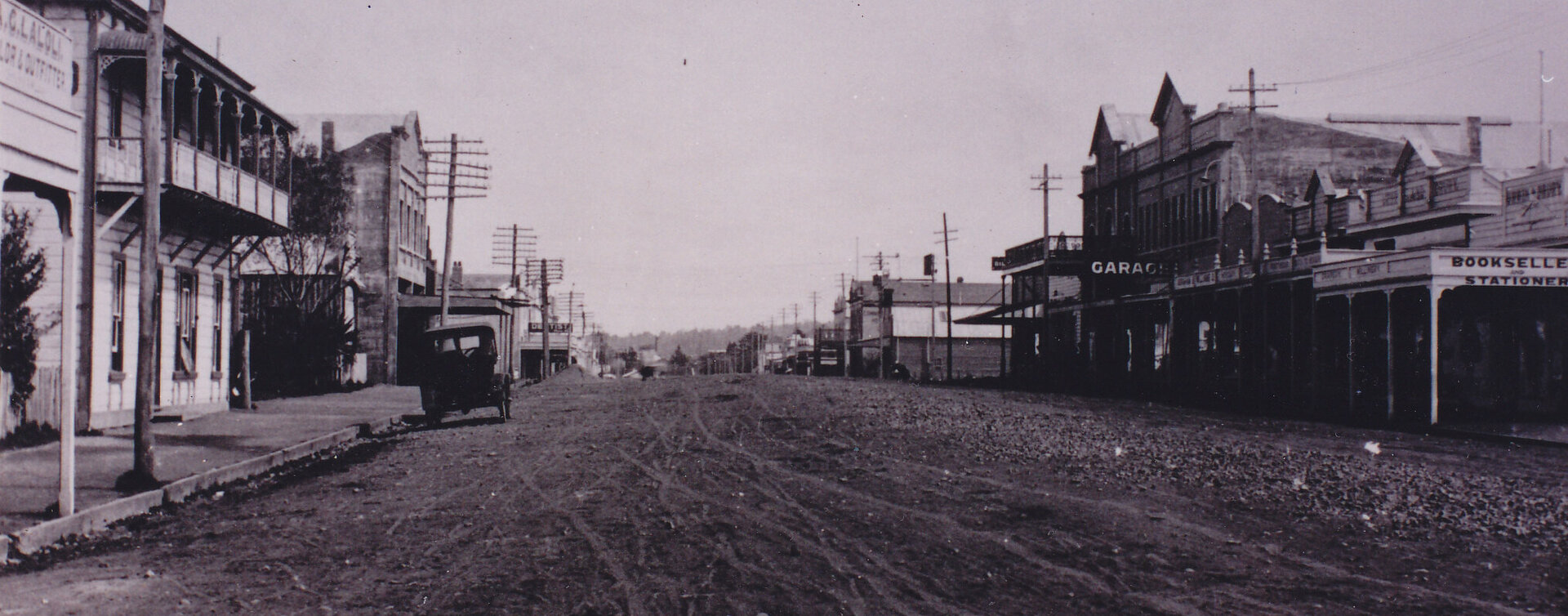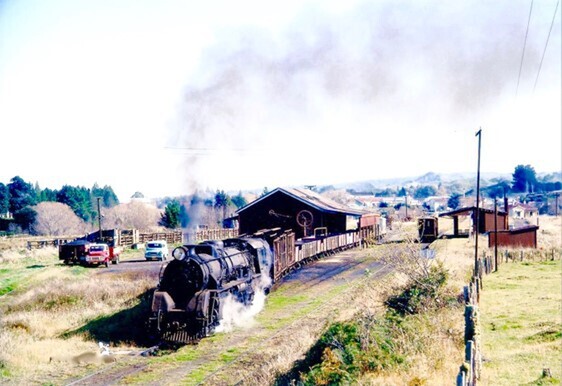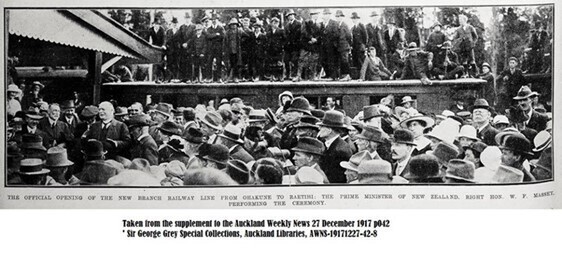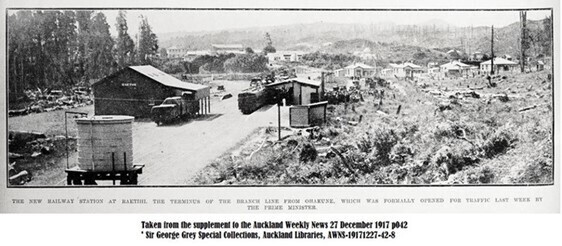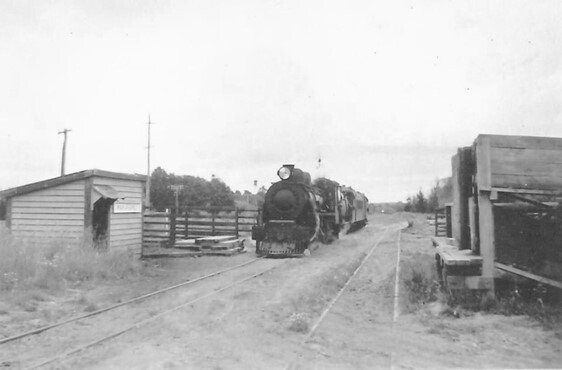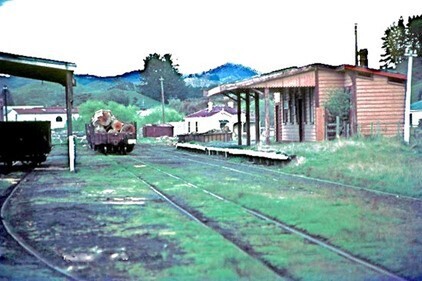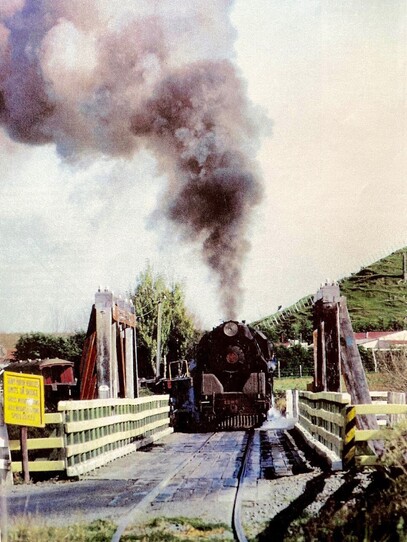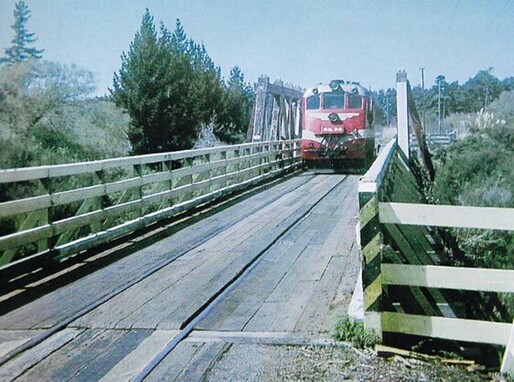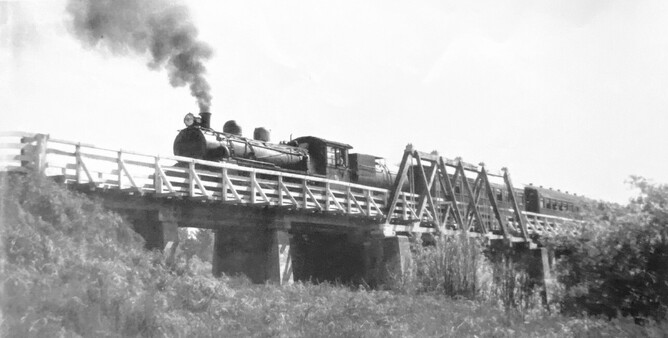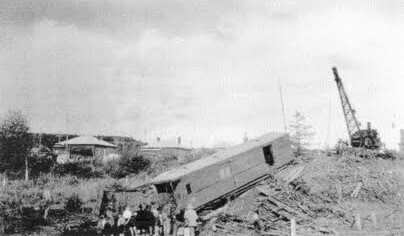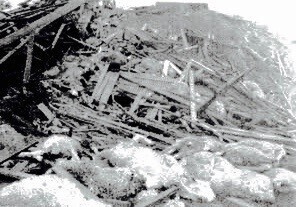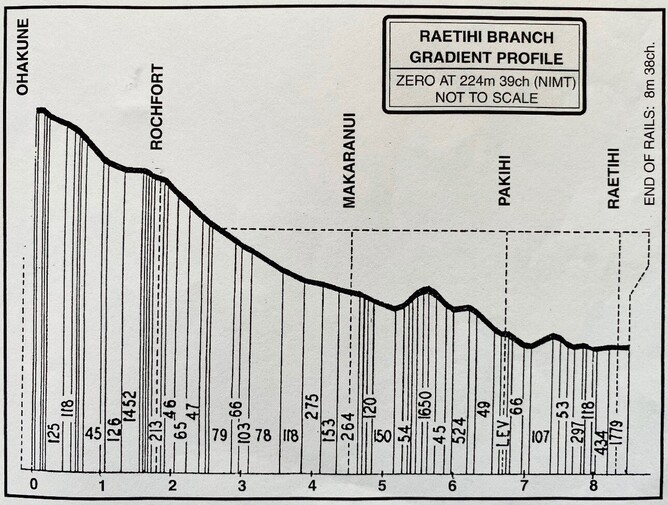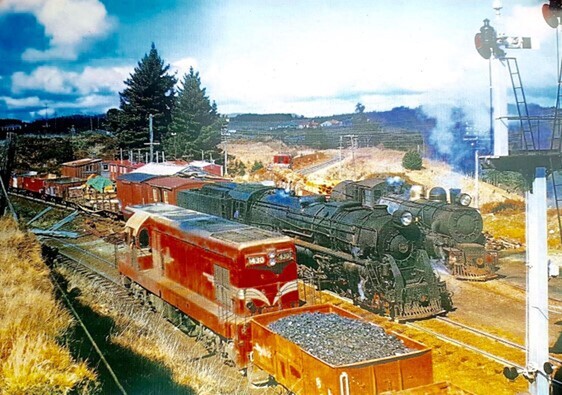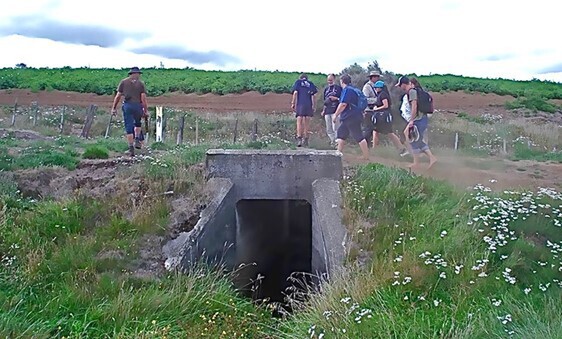Oil-fired Jb 1203 steam locomotive heads a consist of empty wagons from beneath the Raetihi goods shed veranda. At left is Trev. McCoy's Bedford J series truck ready to be loaded with bagged coal from an La wagon. Note the extensive stockyards behind and the one and a half ton whippet yard crane beside the goods shed.
23 April 1964. Photo: Keith Cullen.
By Rob Bowater
Raetihi was fortunate to have been the only town between Palmerston North and Frankton to be connected to the North Island Main Trunk route by a railway branch line.
The 8.5 mile (13.7 kilometre) branch line served the district for 50 years from late 1917 to the end of 1967. Initially the new rail route opened for mixed passenger and freight trains. From 16 December 1951 it was used to transport only goods, stock, wool and timber. Highways had improved and folk preferred to travel in vehicles.
Early Beginnings
On 3 April 1908 a survey party was in Ohakune Junction to make a start when Ohakune people wanted the route near to their town and petitioned the government. Six different routes were looked at plus Maori in the area had to be convinced of the line’s benefit. A deputation even went to Wellington regarding the route. Rangataua residents in their deputation also wanted the connection to be near their town.
In 1911 Parliament announced a £15,000 vote to construct the line which had been approved under the Railway Authorisation Act of 29 October that year. On 12 February 1912 the first sod was turned at Ohakune Junction by the Minister of Works, the Hon R. McKenzie, who afterwards was presented with the silver spade that was used.
It was expected that the branch line would cost £45,000 and take 18 months to construct. However, early progress was slow under contract arrangements. Labour was short as men were away at World War 1. In January 1914 contracts were abandoned and the Public Works Dept. took over, employing 90 men to work on the Ohakune west to Makaranui section. Progress was still slow. A goods service was started in August 1916 by the Works Dept. and this was well patronised. A year later the line was completed to Makaranui where the initial goods service ended. When completed the Branch cost £88,000.
Grand Opening
On 18 December 1917 in front of a large crowd at the Raetihi station, Premier, the Right Hon. W.F. Massey officially opened the line. That day six return train trips to the Junction were well patronised. An evening celebration banquet was held in the Raetihi Drill Hall. On 19 March 1918 a relief train took about 200 frightened folk from Raetihi to escape the terrible fire that swept through the district. That year two mixed passenger/freight trains ran daily. Trips took about 35 minutes at maximum 40 km/hour and reduced 10 and 32 km speeds over the Mangawhero river’s road/rail bridge at Makaranui. In March 1919 a Saturday service was approved and popular.
In the first month 84,052 super feet of timber and 3,081 tons of produce was carried to the Junction and 2,898 tons of goods railed westwards to Raetihi. Over the years the main outgoing freight was sheep, cattle, sawn timber from local native forests and wool. In latter years logs were the main export. Cattle were transported in H class and sheep in J class wagons. Raetihi had regular large ewe sales. La & L wagons along with the guard’s van were used for general cargo. From an A.B.C. beer bottle depot at Rochfort consignments of empties were railed back to the Auckland brewery.
Flag Stations
There were three flag stations established en route on the branch line.
Rochfort : 3.1 km from Ohakune Jtn. A flag stop with lean-to shelter, goods shed plus loop and siding.
Steam loco. Ab700 heads a train at the Makaranui flag stop. At the left is the shelter shed and stock pens. On the right is the loop line and stock loading bank.
8 January 1961.
Makaranui : 7.5 km from Ohakune Jtn. A flag stop with shelter, stock pens, loading bank. 33 wagon backshunt and 15 wagon siding. This station closed about 1959.
Pakihi : 10.9 km from Ohakune Jtn. Home of the Makatuku Timber Company.
Looking along the Raetihi yard with a wagon of logs at centre awaiting despatch. Note at right the station building with a NZR house behind.
30 September 1967 Photo: Russ Bidgood.
At Raetihi : Basic lean-to station building with extensive verandah featuring three sets of skylights, goods shed, stockpens, loading bank, 1.5 ton whippet hand crane, 42 wagon capacity loop, 28 wagon siding (goods shed), 13 wagon auxilliary siding, 18 wagon backshunt (stock pens), water vat, coal & firewood bin. There were no signals installed along the Branch. At Raetihi there were four New Zealand Railway-styled houses built in adjoining sections facing the station yard. These housed railway employees and their families. Only one house remains today. Staff at the station varied in numbers, but mainly there was just the stationmaster and porter /office clerk.
Bridges
There were four bridges on the Branch. No 1 was a 22 ft steel beam over the KoroKoro stream. No 2 was a 18.3 mtre wooden truss bridge over Mangawhero River at Makaranui with steel beams and a timber through-truss centre section. No 4 was a timber beam bridge on Smith’s Mill Road.
Steam loco Jb 1203 crosses the Mangawhero river road/rail bridge at Makaranui. February 1964.
On March 5 1966 an excursion on John Murphy's RM33 railcar travelled on the Branch. Here it is crossing the Mangawhero road/rail bridge at Makaranui.
Locomotives
Over the years various locomotives were used to haul the trains on the Raetihi Branch. In the earlier steam era classes used were F, Fa, R, Wa, Wf, Aa, A6, Wg and oiled-fired Jbs. After steam locos were taken out of service during winter of 1967, diesel power took over. Then diesel classes Ds and DSA were used for the remaining months. Steam locomotives would be allocated to Taumarunui where maintenance was carried out and sub-shedded to Ohakune.
Excursions
6 November 1958 : Three return trains for the 50th anniversary of the North Island Main Trunk at Ohakune;
21 October 1961 : N.Z. Railway & Locomotive Society’s Labour Weekend reunion tour;
5 March 1966 : John Murphy’s Standard RM33 railcar return trip.
Raetihi Primary School annual picnic to Allen’s farm at Makaranui was always looked forward to especially as the pupils, teachers and some mothers travelled to and from the venue in a train powered by a steam-hauled loco.
Heading a train during the Labour weekend excursion is loco. Ab700 returning to Ohakune. The train is crossing the road/rail bridge at Makaranui. 21 October 1961. Photo: Trev. Terry.
Major Runaway Accident
On 15 February 1930 at 2.55am 15 loaded sheep wagons from a Raetihi ewe fair became detached from a train in slippery conditions on a steep grade a mile from Ohakune. It is said a coupling snapped.The runaway wagons and unoccupied guard’s van freewheeled and picked up speed as they made their way back to Raetihi. The sounds of the runaway careering down a 332 ft altitude decline could be heard in the still night air. The guard’s van ploughed through the Raetihi stopblock and ran down the bare hill for half a chain, coming to rest upright with its wheel buried. Eleven packed sheep wagons followed it and were smashed to matchwood. Reports stated that 387 sheep were immediately killed, but many more could have eventually perished through injuries. All those killed were buried. A steam crane was brought in to recover the guard’s van.
The only major accident on the branch line was on February 15 1930 when 15 runaway loaded sheep wagons and guard's van crashed through the stop block at the end of the Raetihi station yard in the early hours. Hundreds of sheep were killed as the wagons were concertinaed behind the van. Above: A steam crane helping to recover the van with a group of folk looking on.
Some of the wagon debris and dead sheep. Photos: J Moorman (John Fitzgerald collection)
Gradient profile Ohakune - Raetihi.
At Ohakune Junction showing the Raetihi Branch leading off to the right with a train headed by an Ab steam locomotive. On the other two busy rails is a Ka steam loco and a Da diesel loco hauling freight consignments.
Branch Death Knell
On 29 May 1962 Railways Minister Mr J.K.McAlpine and NZ Railways General Manager Mr A.T. Gandell visited Raetihi to impress on a packed Theatre Royal that the Branch’s future relied on the“Use it or lose it” approach. The town’s business sector had closed their doors for just over an hour in the early afternoon for the meeting with many placing prominent protest placards outside their premises.The minister gave a twelve-month reprieve on the pending closure, much to the relief of the locals. Welcoming the two guests were Raetihi’s mayor Jack Duggan and Waimarino County chairman Dave Berry. But the Branch, with dwindling freight, amazingly kept open for just over another five years. Prior to any defi nite closure announcement consideration was given to retaining the Branch as far as Makaranui for log transportation, but this was not to be. In September 1967 it was announced that closure would be at the end of December that year.
The final goods train headed by DSA 221 departed from Raetihi station on 27 December 1967. With green flag in hand, the last stationmaster Western Samoan-born Mr D Schuster, farewelled it.
On January 1 1968 the Branch closed for good.
Station Building’s New Life
Following Raetihi station building lying idle for eleven years efforts were made to acquire it for a district museum. Waimarino Museum Society had become incorporated and needed a building.
In 1979 Raetihi Borough Council gave the station building for removal and a site in Seddon Street to the society along with one of the railway houses for materials for upgrades. The building was shifted to its new site in April 1981. After the society launched a postal public appeal $2,025 was realised. With the assistance from the Borough Council, Rotary Club, Sports & Recreation Fund plus the Whanganui Savings Bank the society was successful in achieving the ambitious project. Today the museum building stands proudly in its traditional railway colours beside Raetihi’s main street complete with appropriate NZR signage. Viewers will note the four-wheeler with rusty chassis mounted on a set of rails outside and the old borough road grader sheltered beneath the verandah. Inside are many treasures from the district which surely will be cherished by generations to come.
In the sparce former station yard the goods shed remains on site, but its brick chimney has gone and the east-facing side verandah altered. It sees more trucks these days. Whilst the branch line rails and sleepers were uplifted and salvaged early on, many concrete foundations and culverts still remain along the old rail route. Nothing is left of the Rochfort and Makaranui flag stations.
New Heritage Bridge
Former wooden No 2 rail truss bridge over the Mangateitei stream beside SH49 near Ohakune has been replaced by the owners of the property, Scott and Dana Graham. Following years of neglect in an overgrown state they engaged an engineering fi rm to replace the entrance bridge into their private property to the same design and materials as the old one, complete with a set of rails. Constructed in 2012 they received a rail heritage restoration award from the Federation of Railway Organisations of NZ, the following year. A number of railway enthusiast groups (one called Rusty Rails) have walked and viewed the former route, no doubt reminiscing about those noisy trains that once powered back and forth for half a century to serve the small Waimarino town of Raetihi.
Some of a Rusty Rails group of rail enthusiasts walking over a concrete culvert on the former Branch line.
Rob Bowater
Sources : Rob Bowater, personal recollections & his 1967 News View (a Whanganui Chronicle newspaper) story.
- The late Kevin Ward, Hamilton, Rail Fan magazine story.
- Merrilyn George, Ohakune book.
- Waimarino Museum Society (Inc) , Some Early History of the Waimarino.
